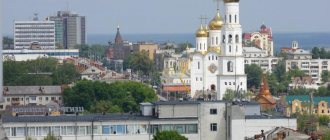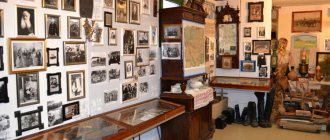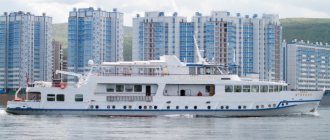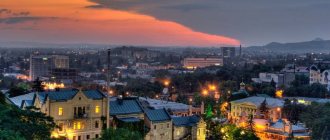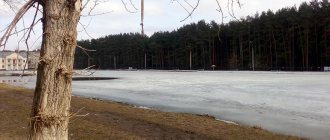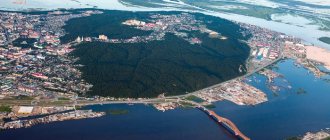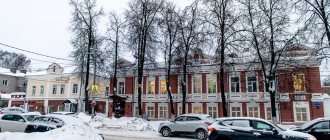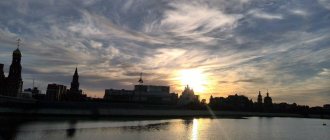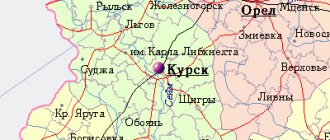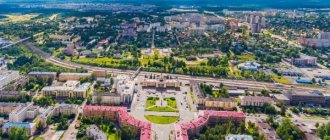- May 6, 2019
- Directions
- Elena Erokhina
Most of the capital's indigenous residents know where the city of Podolsk is located. After all, it belongs specifically to the Moscow region. The city grew up on the site of the village of Podol, from which it received its name. In the Middle Ages, the territory was donated to the Danilov Monastery. The location of the modern city is Pakhra, a right tributary of the Moscow River. We will find out how the settlement has changed during its existence, what attractions of the city you should pay attention to and where you can relax in Podolsk.
Geographical location
Where the city of Podolsk is located becomes clear if you look at the map of the Moscow region. It is located south of Moscow. The urban district includes Podolsk itself and 75 rural settlements. Previously a district city, and since 2015 a city of regional subordination, it occupies an area of 339 km2.
If you are going to visit this part of the Moscow region and want to more accurately understand where the city of Podolsk is located, you should know that the district borders in the northeast with the Leninsky district, in the north, west and northwest - with Moscow, in the east - with Domodedovo, in the south - with the Chekhov district.
City information
Podolsk is the administrative center of the district of the same name in the Moscow region. Located in the west of the Russian Federation, near the Pakhra River. The economy is represented by enterprises of the mechanical engineering, electrical, food, chemical, and metallurgical industries.
Near the settlement there are federal highways: European route E105, Moscow Ring Road. There is a railway connection. There are universities and their branches, professional and secondary specialized educational institutions. The population is more than 220 thousand people.
Development
According to the described geographical location, it is quite clear where Podolsk is located. You won't have to travel long from Moscow. The distance from the center of the capital to the district along the highway is 38 km, which can result in a 20-30 minute drive.
The history of the city dates back to the 7th century BC. In the Dubrovitsky rural settlement, which now belongs to Podolsk, a site of primitive people who lived during the Mesolithic era was found. In the Iron Age, the city was inhabited by representatives of the Baltic and Finno-Ugric tribes. From the 9th-10th centuries AD. e. Slavs live in Podolsk.
It is believed that since the 11th century the city has belonged to the Smolensk principality. However, there are historians who disagree with this statement. Nevertheless, in the middle of the 14th century, the eastern part of the Smolensk Principality, together with the lands on which modern Podolsk stands, went to the Moscow Principality, and in 1559, part of the territory with the village of Podol that interests us was granted to the Danilov Monastery.
It is not very clear in what year the village of Podol was formed, but its development after becoming part of the monastery is quite easy to trace. It began its expansion from the initially formed place of residence at the bend of the Pakhra River, which was a waterway, and the path through the villages became a land road connecting Moscow with other principalities located in the west and south of Rus'.
In subsequent centuries, the development of Podol is associated with the Serpukhov road, which during the years of confrontation with the Crimean Khan acquired not only food, but also military-strategic importance. At the end of the 18th century, the settlement left the subordination of the monastery, and its residents began to pay taxes to the Moscow treasury, which significantly eased the situation of the peasants.
A little later, Podol was transformed into the city of Podol-Pehra, which became the center of the Podolsk district of the Moscow province. However, until the middle of the 19th century, village life was still characteristic of the settlement. It cannot yet be called a city inhabited by merchants and industrialists. Since the second half of the 19th century, a brewery, tannery, waxing and malting plant, brick factories and a cement factory appeared in Podol. The industrial development of Podolsk began. It is difficult to say which area of production was more successful in those years. Residents and industrialists did a little bit of everything. However, by the 20s of the 20th century, 95% of all goods exported from the city were directly related to construction. Many famous cultural heritage sites were built in the capital from materials produced in Podolsk.
In the post-war period, the construction of industrial facilities in the city continued at an accelerated pace, and the number of residents also grew. Podolsk became the first city in the Moscow region with a population of more than two hundred thousand people.
And in the 21st century, the city continues to be a leader in industrial production, having taken on additional workload and located on its territory a number of enterprises in the scientific industry, including those involved in atomic research.
Since 2004, the territory where Podolsk is located began to be called an urban district. In 2015, its area expanded significantly due to two former municipalities: the Podolsk municipal district and the urban district of Klimovsk.
Local government
The structure of local government bodies of the municipality is [22]:
- representative body - Council of Deputies,
- head of the city district,
- city district administration,
- Chamber of Control and Accounts.
The highest officials are the head of the city district (from October 16, 2015 Pestov Nikolay Igorevich) and the chairman of the council of deputies (from April 27, 2022 Mashkov Dmitry Nikolaevich). The Council of Deputies is represented by the parties United Russia (25 deputies), the Communist Party of the Russian Federation (5 deputies), as well as the RPPS (2 deputies), A Just Russia, Yabloko and LDPR (1 deputy each).[23]
The city district has 6 territorial structural divisions of the city district administration[24]:
- Territorial Administration "Klimovsk" - Head Pavel Viktorovich Laptev
- Territorial department of "Dubrovitsa" - head Valery Vasilyevich Boyarko
- Territorial department "Lagovsky" - head Nikolai Ignatievich Ovsyannikov
- Territorial department "Lvov" - head Alexander Sergeevich Litvin
- Territorial department "Strelkovsky" - head Elena Petrovna Dolgikh
- Territorial department "Grasshoppers" - head Evgeny Viktorovich Patrushev.
English copy
People who have never been to Great Britain, but have heard a lot about the beauties of London, want to see the famous Big Ben tower. And what do you think? A copy of it can be seen in Podolsk. What other region of Russia, besides Moscow, can offer such an architectural creation? Of course, this tower only functionally resembles the original. However, its installation in the city’s anniversary year in the Square of Generations is undoubtedly important for the residents of Podolsk. Next to the tower there is a fountain, flower beds and lanterns, and on it, in addition to the clock, there is a coat of arms attached.
Flag
The flag of Podolsk is made in the form of a rectangular panel. The ratio of its sides is 2:3. It is divided into two parts: blue and red. The latter is located along the upper horizontal edge and occupies 1/5 of the length of the panel. The first depicts the main elements of the coat of arms - two golden pickaxes placed crosswise.
The artistic composition was approved on April 22, 2005 (decision No. 33/11). Included in the State Heraldic Register of the Russian Federation under No. 2641.
Temples
Residents recommend visiting the Church of the Sign not only for those who are deeply religious, but also for ordinary people who are not related to the church. This building is located in Dubrovitsy. If you don't know where to go in Podolsk, go to this pearl of the Moscow region. It amazes not only with its appearance, but also with its interior decoration. The temple is crowned with a dome in the shape of a crown, and the building’s ceilings feature original white stucco molding on a blue background and a number of sculptural compositions. In addition, nearby is the extraordinary noble estate of B. A. Golitsin.
Despite the fact that all valuable exhibits have been removed from the building and excursions are not held there, you can admire the building, which combines baroque and classicism. Today, the registry office is located in the estate, and there is a linden park around it. Behind the church there is an elevation in the form of a mound, on which there is an observation deck. Married couples come here to secure a symbolic lock. From the elevation you can observe the confluence of two rivers: the Desna and Pakhra.
Special attention should be paid to the Church of the Resurrection of Christ. A wooden structure on the site of a modern work of art appeared during the time of Ivan the Terrible. In the 30s of the 18th century, the temple was rebuilt using stone and other durable materials. During its existence, the church was restored more than once. The last restoration was carried out at the end of the 20th century. Since then, the operating temple has been pleasing believers and guests of the city.
Coat of arms
The coat of arms of Podolsk is presented in the form of a French shield. The historical version approved on December 20, 1781 is taken as the basis.
On an azure background there are depicted two golden pickaxes placed crosswise. In the free part there is the coat of arms of the Moscow region in the form of a quadrangle.
Reproduction is allowed in two versions: without the free part or with it. Can be performed in a solemn image: with a ribbon of the Order of the Red Banner of Labor and a status tower crown with five visible teeth.
The artistic composition was adopted by decision of the city Council of Deputies No. 30/17 of December 24, 2004 (re-registered on June 30, 2006). Included in the State Heraldic Register of the Russian Federation under No. 1801.
Horse Club
Who said that children only need games? Communicating with animals is a good way to spend time. We invite you to visit the Sivka club in Podolsk. Where this place where you lose track of time can be found on the official website. Club address: Shchapovskoye settlement, Pesye village. Horses of different colors and professional trainers are brought together here. You can ride at any time of the year, since there is both an indoor arena and an outdoor parade ground. There are separate lessons for beginners, as well as individual and group lessons.
Park named after Victor Talalikhin
If you are still wondering where to relax with children in Podolsk, and the equestrian club is not suitable for you, then visit the entertainment club, which was founded almost a hundred years ago. Initially, this was done for the purpose of greening the city. Then a stage for performances by amateur groups appeared there, and then an indoor amphitheater was built that could accommodate up to five thousand spectators.
A huge amount of work to bring the park into proper condition was carried out in the post-war period. In addition to the appearance of new alleys, planted shrubs and trees, the park delighted guests with sculptural compositions, a dance floor, and play pavilions. A children's playground and many attractions were installed.
Podolsk Local Lore Museum
Perhaps every resident of the city knows where this historical place is located. We inform guests that the museum is located in house No. 7 on Sovetskaya Square and is a must-visit. Since 1971, the building has housed a rather interesting exhibition covering a huge period and telling about the fate of the city. Visitors note the polite staff and the newest trend of the museum - an audio guide with a sightseeing tour.
Also, thematic exhibitions are constantly held here, folk goods are sold, and performances for children and adults are held. In honor of some holidays, exhibition hall employees offer walking tours around the city. That is why, if you find yourself in Podolsk on the eve of a famous historical date, find out about such events and be sure to visit the main exhibition of the museum.
Resettlement of residents by district
Construction of Podolsk is proceeding at an accelerated pace. Currently, the city has 14 districts: Krasnaya Gorka, Yubileiny, Novo-Syrovo, Mezhshosseyny, Zalineiny, Central, Zelenovsky, Parkovy, Ivanovsky, Kuznechiki, Shepchinki, Fetishchevo, Kutuzovo and Vysotny. The latter is modern, green and friendly to live in. Many industrial productions are located in Zalineiny. That is why the population of Podolsk is practically not represented here. Zelenovsky is the most prestigious, central district of the city.
Showroom
Undoubtedly, this is one of those places where it is important to go today in Podolsk. In our time, when the feat of the Soviet man during the Great Patriotic War continues to be sung by the grandchildren and great-grandchildren of ordinary soldiers, a visit to the permanent exhibition called “Podolsk residents in defense of the Fatherland” is mandatory. It will be especially useful to study the exhibits by children in order to educate true patriots of Russia. Guests are also invited to listen to a film and slideshow about the city's history. The hall is located on Lenin Avenue, 113/62. Sometimes it offers its exhibition space for exhibitions of children's creativity and crafts.
Museum-Reserve "Podolia"
The open-air area in Podolsk is quite interesting for visitors. You can find out where this place is located from the townspeople or on the official website of Podolia. It also describes the main reasons why you should visit the historical part of the city. Firstly, fresh air will be useful to you, and there is plenty of room to wander there, because the area of the reserve is 13 hectares. Secondly, it is recommended to familiarize yourself with the interesting landscape and the various fruit trees growing there. Thirdly, you can see archaeological exhibits and architectural monuments.
Also in the Morozov house on the territory of the reserve there is an entire archaeological exhibition. There is also a house-museum of V.I. Lenin.
Location of Podolsk
The location of the town is the Moskvoretsko-Oka Plain, which is part of another plain - the East European Plain, namely its center. Podolsk settled on both banks of a river called Pakhra. Moreover, the main zone of the town is located on its right bank.
4039 hectares is the area occupied by the city of Podolsk.
The most famous fountain of Podolsk
What region of Russia can still boast a thematic sculptural composition “Natasha Rostova’s First Ball”, which is partially opened and then closed by jets of water? It is also noteworthy that the characters are modeled after the actors who played roles in the film adaptation of the novel “War and Peace.” Bolkonsky was played by Vyacheslav Tikhonov, and Rostova was played by Lyudmila Savelyeva. It is their silhouettes that are visible on the pedestal in the center of the fountain. The sculpture was unveiled on Lev Tolstoy Boulevard and completed the overall composition of the pedestrian zone. The authors and creators of the work of art were Podolsk architects Alexander Grammatchikov and Mikhail Korolev and sculptor Andrey Pliev. From a distance, the dancing couple looks quite believable, and even up close, Bolkonsky’s admiring gaze and the effect of Natalia’s moving dress add completeness and laconicism to the sculpture.
Famous estates
If you are interested in the history of Russia, studying architectural buildings and memorable places of different eras, then you have a direct route to Podolsk. Travel agencies and old-timers of the city know where you can go on vacation with a high school-aged child or take a whole class on an excursion. The three estates will attract the attention of not only adults, but also children who consciously chose these places to visit.
The Ostafyevo estate was built at the end of the 18th century by Prince Vyazemsky Andrei Ivanovich. Famous contemporaries of the owner came here, and Nikolai Mikhailovich Karamzin, who married the owner’s daughter, wrote here “The History of the Russian State” for 12 years. Throughout the 19th century, the estate was visited by: V. A. Zhukovsky, A. S. Pushkin, D. V. Davydov, A. S. Griboedov, A. I. Turgenev, N. V. Gogol.
Today the full name of the historical building of the State Museum-Estate “Ostafyevo” is “Russian Parnassus”. It offers several types of reviews and a number of thematic events, including:
- Sightseeing tour of the halls and area around the museum.
- "N. M. Karamzin - life and works.”
- Decoration of the Ostafevsky house.
- Interactive program “Kaleidoscope of names, events, faces.”
- “Three hundred years of medals in Russia.”
- Manor park in Ostafyevo.
- Evening program “It seems to me that there will be a lot there...”.
- Visit to the Church of the Life-Giving Trinity in Ostafyevo.
- "A. S. Pushkin and Ostafyevo.”
- Ecological trail “Unusual in the ordinary”.
- Educational program “Architectural styles. Ostafyevo as a monument of the era of classicism."
- Quest “Secrets of the Manor Park”.
- Educational program “Moscow Sights”.
- Interactive program “Ostafievskie gatherings”.
A visit to the Ivanovskoye estate in Podolsk will also be educational for children and their parents. Where this historical building is located can be understood from its name. And those who are especially curious should definitely visit the village of Ivanovskoye, because today the Federal Museum of Professional Education of the Moscow Polytechnic University operates there.
Experts note that this is a unique place, perhaps the only one of its kind. The work of students of vocational schools is presented here, ranging from embroidery and theatrical costumes to wood, cast iron, technical devices and models. Nearby, in the outbuilding, there is a museum of a communal apartment, the exhibits of which immerse visitors in the second half of the 20th century.
There is also a small church and a theater on the territory, where various concert programs of musical groups from Podolsk are held. Which area of vocational education can attract your child when visiting the museum of the Polytechnic University, that specialty, perhaps, he will choose in the future. Let the student look at the students' work presented in the exhibition. Suddenly, a visit to the museum will change the student’s consciousness, allowing him to look into the future and make an informed choice.
Monuments
Guests of the city should pay special attention to several more sculptures located in the city. Since Catherine II granted Podolsk the status of a city in 1781, residents decided to depict the queen in metal. In 2008, the monument took pride of place in Catherine Square. On a pedestal lined with granite slabs, Catherine herself sat at the table. With a pen in hand, the queen may be about to sign an important sovereign decree. Despite the historical facts regarding the name of the city, there is a legend that the village of Podol was named so because of an event that happened in the life of Catherine the Great. They say that the queen wet herself from the royal dress while passing by the place where the city is now located.
Thus, Catherine’s services to the city are priceless. Residents of Podolsk could not help but thank the autocrat. According to the author's plan, the monument is made of bronze, weighs about two tons and depicts the queen with a slight shadow of a smile on her face, which gives the image the liveliness and democracy characteristic of Catherine II.
It is impossible not to mention the monument “Podolsk – a city of the working class”, which is installed next to the station and seems to greet all guests. Erected in 1969, the monument was intended to show the power and strength of the worker, capable of coping with heavy physical loads and building a bright future. With its greatness it reflects the patriotism of the workers of those years and pride in their small homeland.
The monument to Podolsk cadets, erected in 1975 on Victory Day, still attracts the attention of the younger generation. The courage of the soldiers called to defend Moscow from the infantry and artillery schools is reflected in their gaze. Behind them flutters a banner that does not allow even for a minute to think about retreat. After all, a step back means the death of relatives, the victory of the enemy and the capture of the capital. A diagram of combat operations is placed in front of the fighters. Historically, several thousand cadets during the Great Patriotic War were sent to defend the approaches to Moscow. In addition to the monument, in Podolsk there is a street named in honor of students who heroically fought for peace.
Podolsk urban district: history and modernity
The first mention of the village of Podol, which belonged to the estate of the Danilov Monastery, is contained in church chronicles of 1627-1628.
On October 5, 1781, by personal decree of Catherine II, Podolsk district was formed, and the village of Podol was renamed the city of Podolsk. In 2017, this historical event celebrated its 236th anniversary.
Podolsk land is directly connected with the events of the Patriotic War of 1812. After the Battle of Borodino, troops led by M.I. Kutuzov, passing through Podolsk, took up defensive positions in the area of the village of Krasnaya Pakhra, Podolsk district, then approached Tarutino, setting up a camp here. The famous Tarutino maneuver determined the entire further victorious course of the war with Napoleonic army.
After the Patriotic War of 1812, Podolsk and Podolsk district restored and expanded their economic functions, primarily trading. This, in particular, was facilitated by the construction of the Warsaw (Brest-Litovsk) highway in 1844-1847, as well as the construction of a bridge across the Pakhra River. In the 40s, 13 manufactories operated in the county.
In 1900, an American mechanical plant was founded in Podolsk to assemble sewing machines and produce parts for them. It is to him that the city owes its economic growth at the beginning of the 20th century. became one of the city-forming enterprises of Podolsk.
Of the cities near Moscow, Podolsk in the second half of the 19th century stood out for its highest population growth rates. In 1917, the city had a population of 19 thousand. Stone buildings of a real school, a cinema, a power plant, and a water supply system were built.
During the first five-year plan, economic growth began. Continued to expand, other enterprises opened. The production of new types of products was established, many of which were mastered in the country for the first time: oil equipment, mine electric locomotives, and the first Soviet caterpillar tractor was created.
In the mid-30s, Mosoblproekt developed a plan for Bolshoi Podolsk. It provided for the division of the city into a residential zone and an industrial zone; the central and new streets were supposed to be built with multi-storey residential buildings with all types of public services. Plans during this period were not destined to come true. The Great Patriotic War began.
From the very beginning of the war, Podolsk became an outpost on the southern approaches to the capital. In June 1941, a fighter battalion was formed from city residents, in July a people's militia battalion was formed from volunteers, which later joined the people's militia division of the Kirov district of Moscow, and in October a working regiment, staffed by workers from the Podolsk Mechanical Plant named after Kalinin, went to the front.
A reconnaissance detachment, formed in October 1941 by the city committee of the Komsomol in the interests of the 43rd Army, operated behind enemy lines. At the same time, two partisan detachments were formed and carried out operations on the territory of the Ugodsko-Zavodsky district. In November 1941, partisans took part in the defeat of the headquarters of the enemy's 12th Army Corps.
In October '41, the cadets of the Podolsk infantry and artillery schools covered themselves with unfading glory, having at the cost of their lives blocked the fascist hordes' path to Moscow in the Warsaw direction. Georgy Konstantinovich Zhukov called their feat a symbol of the heroism and valor of the defenders of the Fatherland, which will forever go down in world military history. About two and a half thousand future commanders died on the battlefields, but thanks to their self-sacrifice, the time necessary for the approach of Headquarters reserves was gained, and the direction to Moscow through Podolsk along the Warsaw Highway was closed to the enemy.
On the occasion of the 75th anniversary of the cadets’ feat, the All-Russian public organization of veterans of the Armed Forces of the Russian Federation established a commemorative medal. In September 2016, on the initiative of the Public Chamber of the City District of Podolsk, by decision of the Council of Deputies, October 5 was declared the official Day of Remembrance of Podolsk Cadets in the district.
The whole country knows the feat of the legendary pilot Viktor Talalikhin, deputy squadron commander of the 177th Fighter Regiment of the 6th Fighter Aviation Corps, based near Podolsk (Kuznechiki airfield) and performing air defense missions for Moscow. For the first night ramming on August 7, 1941, V.V. Talalikhin was awarded the title of Hero of the Soviet Union. A Komsomol pilot died in an air battle near Kamenka near Podolsk on October 27, 1941.
Today, on the site of the former Kuznechiki airfield, there is a large microdistrict of Podolsk, built by the Russian Ministry of Defense for military families. Two streets in the microdistrict are named after the heads of the Podolsk infantry and artillery schools - Major General Vasily Andreevich Smirnov and Lieutenant General of Artillery Ivan Semenovich Strelbitsky.
During the war, the Central Women's Sniper Training School was located on the territory of the city. Six of her students were awarded the title of Hero of the Soviet Union. A street in the center of Podolsk is named after one of them, Tatyana Baramzina.
From July 1941 to April 1945, junior lieutenant courses operated in Podolsk, training over 22 thousand officers. In total, more than 150 military formations were formed on the territory of the city and region, heroically defending Moscow; many of these units traveled the roads of war all the way to the fascist lair. In October 1941, by a Decree of the State Defense Committee of the USSR, it was included in the main defensive line of the Moscow Defense Zone.
More than 33 thousand workers of Podolsk and the Podolsk region participated in the construction of defensive structures. In the most difficult front-line conditions, within two weeks, all equipment and material assets of enterprises were sent to the deep rear of the country. On the basis of the factory workshops, workshops were organized for the production of grenades, sapper and construction tools, repair of artillery pieces, aircraft, tanks, mortars, vehicles and other military equipment. On the instructions of the Defense Committee, in one month the workers of the Ordzhonikidze machine-building plant built an armored train, which was given the name “Podolsk Worker”. On January 2, 1942, his ceremonial transfer to the command of the 43rd Army took place. There were 30 hospitals operating on the territory of Podolsk and the region, which returned thousands of wounded to service.
Podolsk land raised 42 Heroes of the Soviet Union, four full holders of the Order of Glory. For courage and heroism shown at the front and in the rear, over 10 thousand Podol residents were awarded orders and medals of the state.
In the post-war period, Podolsk continued to work for the country's defense. Among the well-known enterprises of the defense complex are OKB Gidropress, PNITI, Podolsk Electromechanical Plant, TsNIITOCHMash, KBAL, Klimovsky Stamping Plant.
Enterprises such as the Kalinin plant, the Ordzhonikidze plant, the cable plant, the chemical-metallurgical plant, the battery plant, the Klimovsky plant named after Doenin and many others have gained worldwide fame.
In 1971, by Decree of the Presidium of the Supreme Soviet of the USSR, Podolsk was awarded the Order of the Red Banner of Labor for the successes achieved in fulfilling the tasks of the five-year industrial production plan.
In 2005, to commemorate the 60th anniversary of the Great Victory, by decree of the government of the Moscow region, the city was awarded the Standard of Glory.
In accordance with the Law of the Moscow Region of May 22, 2015, the cities of Podolsk, Klimovsk, the urban settlement of Lvovsky, and the rural settlements of Dubrovitskoye, Lagovskoye and Strelkovskoye of the Podolsk municipal district were united into a single municipal entity, the Podolsk Urban District. The area of the district is 33.9 thousand hectares, the population is 328,583 people.
Bolshoi Podolsk continues to be one of the dynamically developing municipalities of the Moscow region. The district's economy employs 142 thousand people. More than 1,300 manufacturing enterprises operate on its territory, of which 69 are large and medium-sized organizations in the field of manufacturing. More than 40 thousand residents are employed in small and medium-sized businesses.
The urban district of Podolsk is among the leaders in the field of housing construction, a major road and transport hub, one of the most comfortable municipalities in the Moscow region. The social sphere is developing dynamically - healthcare, education, culture, sports.
There are more than 120 public groups operating in the district. Sister-city relations are maintained with more than 20 cities of the near and far abroad and Russia.
Attractions
Podolsk has the status of a historical settlement of regional significance.
In the center of the city there are two famous Orthodox churches - the Trinity Cathedral, built in memory of the victory in the Patriotic War of 1812, and the white stone Church of the Resurrection of Christ, built in 1724.
During the years of Soviet power, Trinity Cathedral was the only functioning city cathedral in the Moscow region. Shrines are kept here: the Jerusalem Icon of the Mother of God, revered by Podolsk residents for deliverance from cholera in 1866; two reliquaries with particles of the relics of 140 saints; Icon of the New Martyrs of Podolsk. The Resurrection Church is one of the oldest churches in Podolsk district. It is mentioned in the scribe books of 1627-1628. At first the temple was wooden, and after the fire it was built of stone. This was the first stone structure in the city. The temple, which was subsequently destroyed, was restored today and today is an architectural decoration of Podolsk.
In recent years, new churches have been built - the Hieromartyr Nicholas on Krasnaya Gorka, Georgievsky in the Kutuzovo district, Aleksandrovsky in the Silikatnaya-1 microdistrict, the Church of Cyril and Methodius in the Silikatnaya-2 microdistrict. Three churches operate in the Klimovsk microdistrict.
On the territory of the former Podolsk region there are 28 historical and cultural monuments - ancient temples, noble estates, ancient parks, the Golitsyn estate complex and the Church of the Sign of the Blessed Virgin Mary in Dubrovitsy, unique archaeological sites.
In the trans-river part of Podolsk there is a historical and memorial museum-reserve “Podolie”. The exhibition gives a broad idea of the history, culture, and life of Podolsk in the 19th and 20th centuries. Part of the exhibition is dedicated to V.I. Lenin.
Podolsk is home to one of the most famous estates in the Moscow region - “Ivanovskoye”. The ensemble in the style of classicism was created at the turn of the 18th-19th centuries. The estate was for a long time the summer residence of the Moscow Governor-General F. Zakrevsky, whose name is associated with the flourishing of public life in Podolsk at the beginning of the 19th century. Today there is a federal museum of vocational education and a branch of the Podolsk Museum of Local Lore, where a collection of archaeological monuments from the south of the Moscow region is presented. In 2012, the local history museum received additional premises in the city center on Sovetskaya Square - in the former building of the Government Places. Here on the square a new unusual attraction appeared - a monument to the famous Singer sewing machine.
In September 2008, a monument to Catherine II was unveiled in Catherine Square, next to the Podolsk station. The Empress was photographed at the moment of signing the Decree granting Podolsk city status.
In Podolsk there are memorial buildings dedicated to the War of 1812 - an obelisk monument to the grenadiers of Miloradovich, who fell on Podolsk land in 1812, and a monument to Mikhail Illarionovich Kutuzov, which is a 22-meter composition, on top of which is a sculpture of Michael the Archangel.
The traditional center of commemorative celebrations on Victory Day in Podolsk is Glory Square, where an architectural and sculptural ensemble dedicated to the Great Patriotic War was built. The Eternal Flame burns here.
One of the main attractions of the city is the monument to Podolsk cadets on the street. Kirov. The composition represents figures of cadets standing next to each other, united by a waving banner with a star at the top. The monument was opened in 1975 - on the 30th anniversary of the Great Victory.
Another monument to the cadets was erected in 2015, in honor of the 70th anniversary of the Victory, on the territory of Klimovskaya gymnasium No. 4, named after the heroes.
In the city park, in 1959, with funds earned by residents, a monument was erected to Viktor Talalikhin, the famous pilot, Hero of the Soviet Union, who accomplished his feat in the sky near Podolsk. In 1969, a monument to V. Talalikhin was erected at the 43rd kilometer of the Warsaw Highway near the village. Grasshoppers, where during the war the 177th Fighter Regiment was located, in which the hero pilot served as deputy squadron commander.
In total, on the territory of the City District there are 54 monuments to those killed during the Great Patriotic War, over 100 memorial plaques.
Podolsk is decorated with sculptural compositions associated with the names of famous people. In 1999, a monument to A.S. was unveiled in the park next to the Administration building. Pushkin - in honor of the 200th anniversary of the poet’s birth. In 2013, in the central part of Podolsk on City Day, the grand opening of the monument to L.N. Tolstoy. Podolsk is closely connected with the name of the writer - Lev Nikolaevich walked three times through Podolsk from his Moscow house in Khamovniki to Yasnaya Polyana. The monument stands on the boulevard named after the writer. In 2014, another attraction appeared nearby - a fountain with a sculptural composition “Natasha Rostova’s First Ball”.
Monuments to the Russian poet M.Yu. Lermontov, whose family roots are connected with the Podolsk region, were installed on the territory of school No. 33 and in the city park of culture and recreation named after V. Talalikhin.
The square near the city registry office is decorated with a monument to the patrons of the family, Saints Peter and Fevronia of Murom.
Podolsk land has a rich history and unique culture. Local folk crafts have gained all-Russian fame and international recognition: wooden toys, lace weaving, beaded jewelry, etc.
Tips for tourists
If the attractions we have described are not enough for you, consider a few more establishments where you can go in Podolsk:
- "Brainslaughter." The ideological masterminds envision spending time in the club, located at 105 Lenin Avenue, in order to conduct an extraordinary game with interesting questions in good company.
- Trap" is a place where you can not only go with your child in Podolsk, but also need to. The establishment is located on the third floor of the Atak shopping center, located on Klement Gottwald Street. There are entire halls for playing table tennis, football kicker, billiards, there is a separate shooting range, tournaments are held with the distribution of prizes, and there is a large screen for watching films.
- “Podmoskovye” is an entertainment complex for adults, also located on Klement Gottwald Street. The nightclub is full of metal, neon and lasers, and the restaurant offers Russian, European and fusion cuisine. There is a separate banquet and wedding hall, as well as a DJ cafe. For entertainment, visitors are offered karaoke, striptease and various show programs.
- “Ivanhoe” is a club located outside the city on the 41st km of the Simferopol highway. Guests can enjoy the following services: a restaurant serving Ukrainian cuisine, a night club, a bowling alley, a hotel, an autodrome, a bath complex and an equestrian club.
- The Mission Progressor quest is the place to go in Podolsk on the weekend, it is recommended if you or your child are fans of games of this kind. The organizers are waiting for participants at the address: Bolshaya Serpukhovskaya street, house 14. The essence of the game is to travel to the planet Arcana, which has a medieval level of development, as part of a rescue team. The exciting plot will appeal not only to children, but also to adults.
Residents of Podolsk definitely recommend that guests with children also visit the Game Zone attractions. You can find them in the Capitol shopping center on Bolshaya Serpukhovskaya Street, 45. In addition to various types of video games, guests are offered air hockey, football and a large labyrinth of several levels.
Compound
The city of Podolsk since 2015 (including the former city of Klimovsk and the former village of Lvovsky) includes:
- the city of Podolsk (local microdistricts (neighborhoods): Krasnaya Gorka, Novo-Syrovo, Parkovy, Zalineiny, Central, Zelenovsky, Ivanovsky, Mezhshoseyny, Yubileiny, Kuznechiki, Fetishchevo, Vysotny, Shepchinki, Kutuzovo), Klimovsk microdistrict,
- microdistrict Lvovsky,
- territorial department Dubrovitsky (Dubrovitsy village, Akishovo village, Bulatovo village, Dokukino village, Zharkovo village, Kuznechiki village, Kutino village, Lemeshevo village, Lukovnya village, Naumovo village, Polivanovo village, Polivanovo village sanatorium Rodina),
On February 15, 2016, by decision of the Council of Deputies of the Podolsk urban district, the word “microdistrict” was excluded from the name of the rural areas of the municipality[25].
Settlements
The urban district includes 76 settlements, including 1 city and 75 rural settlements[26][27]:
| List of settlements in the district | ||||||
| № | Type | Locality | Population (persons) | Former municipal entity until 2015[36] | OKATO[37] | Former administrative unit until 2005[38] |
| 1 | village | Agafonovo | ↗20[28] | Strelkovskoe | 46 246 828 006 | Strelkovsky rural district |
| 2 | village | Akishovo | ↗28[28] | Dubrovitskoye | 46 246 813 008 | Dubrovitsky rural district |
| 3 | village | Alexandrovka | ↗70[28] | Lagovskoye | 46 246 816 015 | Lagovsky rural district |
| 4 | village | Alexandrovka | ↗1218[28] | Strelkovskoe | 46 246 828 010 | Strelkovsky rural district |
| 5 | village | Altuhovo | ↗44[28] | Lagovskoye | 46 246 816 018 | Lagovsky rural district |
| 6 | village | Berezhki[29] | ↗252[28] | Lagovskoye | 46 246 816 026 | Lagovsky rural district |
| 7 | village | Boborykino | ↗31[28] | Strelkovskoe | 46 246 802 004 | Bryantsevsky rural district |
| 8 | village | Bolshoye Bryantsevo | ↗27[28] | Strelkovskoe | 46 246 802 007 | Bryantsevsky rural district |
| 9 | village | Bolshoye Tolbino | ↘67[28] | Lagovskoye | 46 246 816 009 | Lagovsky rural district |
| 10 | village | Borisovka | ↗27[28] | Strelkovskoe | 46 246 828 014 | Strelkovsky rural district |
| 11 | village | Borodino | ↗88[28] | Lagovskoye | 46 246 816 003 | Lagovsky rural district |
| 12 | village | Boryovo | ↗166[28] | Lagovskoye | 46 246 816 028 | Lagovsky rural district |
| 13 | village | Bulatovo | ↗31[28] | Dubrovitskoye | 46 246 813 011 | Dubrovitsky rural district |
| 14 | village | Bykovka | ↗80[28] | Strelkovskoe | 46 246 828 011 | Strelkovsky rural district |
| 15 | village | Bykovo | ↘1567[28] | Strelkovskoe | 46 246 828 001 | Strelkovsky rural district |
| 16 | village | Byakontovo | ↘18[28] | Strelkovskoe | 46 246 828 012 | Strelkovsky rural district |
| 17 | village | Valishchevo | ↗99[28] | Lagovskoye | 46 246 816 013 | Lagovsky rural district |
| 18 | village | Vorypaevo | ↗64[28] | Strelkovskoe | 46 246 802 010 | Bryantsevsky rural district |
| 19 | village | Hryvnia | ↗42[28] | Lagovskoye | 46 246 831 009 | Synkovsky rural district |
| 20 | village | Dmitrovo | ↗61[28] | Lagovskoye | 46 246 816 005 | Lagovsky rural district |
| 21 | village | Dokukino | ↗100[28] | Dubrovitskoye | 46 246 813 003 | Dubrovitsky rural district |
| 22 | village | Dubrovitsy | ↗3362[28] | Dubrovitskoye | 46 246 813 001 | Dubrovitsky rural district |
| 23 | village | Zharkovo | ↗25[28] | Dubrovitskoye | 46 246 813 004 | Dubrovitsky rural district |
| 24 | village | Zhdanovo | ↗59[28] | Strelkovskoe | 46 246 828 003 | Strelkovsky rural district |
| 25 | village | Zheleznodorozhny[30] | ↗1378[28] | Lagovskoye | 46 246 816 022 | Lagovsky rural district |
| 26 | village | Ivlevo | ↗130[28] | Strelkovskoe | 46 246 828 009 | Strelkovsky rural district |
| 27 | village | Koledino | ↗65[28] | Lagovskoye | 46 246 816 027 | Lagovsky rural district |
| 28 | village | Grasshoppers | ↗3298[28] | Dubrovitskoye | 46 246 813 007 | Dubrovitsky rural district |
| 29 | village | Kutino | ↗20[28] | Dubrovitskoye | 46 246 813 006 | Dubrovitsky rural district |
| 30 | village | Lagovskoye | ↘138[28] | Lagovskoye | 46 246 816 010 | Lagovsky rural district |
| 31 | village | Lemeshovo | ↗198[28] | Dubrovitskoye | 46 246 813 002 | Dubrovitsky rural district |
| 32 | village | Forest Glades[31] | ↘214[28] | Lagovskoye | 46 246 816 023 | Lagovsky rural district |
| 33 | village | Lesproekt | ↘263[28] | Lagovskoye | 46 246 816 020 | Lagovsky rural district |
| 34 | village | Lopatkino | ↘6[28] | Lagovskoye | 46 246 816 016 | Lagovsky rural district |
| 35 | village | Lukovnya | ↘9[28] | Dubrovitskoye | 46 246 813 005 | Dubrovitsky rural district |
| 36 | village | Luchinskoe | ↗33[28] | Lagovskoye | 46 246 816 007 | Lagovsky rural district |
| 37 | village | Makarovo | ↗108[28] | Strelkovskoe | 46 246 802 009 | Bryantsevsky rural district |
| 38 | village | Maloe Bryantsevo | ↗146[28] | Strelkovskoe | 46 246 802 002 | Bryantsevsky rural district |
| 39 | village | Maloe Tolbino | ↗53[28] | Lagovskoye | 46 246 816 008 | Lagovsky rural district |
| 40 | village | Matveevskoe | ↗190[28] | Lagovskoye | 46 246 816 014 | Lagovsky rural district |
| 41 | village | Menshovo | ↗39[28] | Lagovskoye | 46 246 816 017 | Lagovsky rural district |
| 42 | village | Youth[32] | 2431[28] | Lagovskoye | 46 246 816 030 | Lagovsky rural district |
| 43 | village | Motovilovo | →5[28] | Lagovskoye | 46 246 831 010 | Synkovsky rural district |
| 44 | village | Naumovo | ↗10[28] | Dubrovitskoye | 46 246 813 009 | Dubrovitsky rural district |
| 45 | village | Nikulino | ↘140[28] | Lagovskoye | 46 246 816 006 | Lagovsky rural district |
| 46 | village | Novogorodovo | ↘18[28] | Lagovskoye | 46 246 831 007 | Synkovsky rural district |
| 47 | village | Novokoledino[33] | 6[28] | Lagovskoye | 46 246 816 029 | Lagovsky rural district |
| 48 | village | Novoselki | ↗43[28] | Lagovskoye | 46 246 831 006 | Synkovsky rural district |
| 49 | village | Horde | ↗20[28] | Strelkovskoe | 46 246 828 016 | Strelkovsky rural district |
| 50 | village | Pleshcheyevo | ↗59[28] | Strelkovskoe | 46 246 828 017 | Strelkovsky rural district |
| 51 | city | Podolsk | ↗309 250[4] | GO Podolsk | 46 460 | — |
| 52 | village | Podolsk machine testing station | ↗1930[28] | Lagovskoye | 46 246 831 011 | Synkovsky rural district |
| 53 | village | Cover | ↗245[28] | Strelkovskoe | 46 246 828 008 | Strelkovsky rural district |
| 54 | village | Polivanovo | ↗509[28] | Dubrovitskoye | 46 246 813 012 | Dubrovitsky rural district |
| 55 | village | Potapovo | ↗143[28] | Strelkovskoe | 46 246 802 003 | Bryantsevsky rural district |
| 56 | village | Puzikovo | ↗10[28] | Lagovskoye | 46 246 831 008 | Synkovsky rural district |
| 57 | village | radio | ↘580[28] | Lagovskoye | 46 246 816 012 | Lagovsky rural district |
| 58 | village | Romantsevo | ↗154[28] | Lagovskoye | 46 246 816 011 | Lagovsky rural district |
| 59 | village | sanatorium "Rodina" | ↘158[28] | Dubrovitskoye | 46 246 813 010 | Dubrovitsky rural district |
| 60 | village | Severovo | ↗299[28] | Lagovskoye | 46 246 816 024 | Lagovsky rural district |
| 61 | village | Agricultural machinery | ↗435[28] | Strelkovskoe | 46 246 828 004 | Strelkovsky rural district |
| 62 | village | Sergeevka | ↗300[28] | Lagovskoye | 46 246 816 002 | Lagovsky rural district |
| 63 | village | Sertyakino | ↘75[28] | Lagovskoye | 46 246 816 004 | Lagovsky rural district |
| 64 | village | Sertyakino | ↗112[28] | Lagovskoye | 46 246 816 019 | Lagovsky rural district |
| 65 | village | Slashchevo[34] | ↗107[28] | Lagovskoye | 46 246 831 004 | Synkovsky rural district |
| 66 | village | Sosnovy Bor[35] | ↗71[28] | Lagovskoye | 46 246 816 021 | Lagovsky rural district |
| 67 | village | Spirovo | ↗52[28] | Strelkovskoe | 46 246 802 008 | Bryantsevsky rural district |
| 68 | village | Strelkovo | ↗156[28] | Strelkovskoe | 46 246 828 002 | Strelkovsky rural district |
| 69 | village | Strelkovskaya factory | ↘69[28] | Strelkovskoe | 46 246 828 013 | Strelkovsky rural district |
| 70 | village | Synkovo | ↗849[28] | Lagovskoye | 46 246 831 001 | Synkovsky rural district |
| 71 | village | Uslon | →14[28] | Strelkovskoe | 46 246 828 005 | Strelkovsky rural district |
| 72 | village | Fedyukovo | ↗2785[28] | Strelkovskoe | 46 246 802 001 | Bryantsevsky rural district |
| 73 | village | Kharitonovo | ↘2[28] | Lagovskoye | 46 246 831 002 | Synkovsky rural district |
| 74 | village | Kholopovo | ↗7[28] | Strelkovskoe | 46 246 828 007 | Strelkovsky rural district |
| 75 | village | Khryaslovo | ↗18[28] | Lagovskoye | 46 246 831 003 | Synkovsky rural district |
| 76 | village | Yakovlevo | ↗134[28] | Strelkovskoe | 46 246 802 005 | Bryantsevsky rural district |

